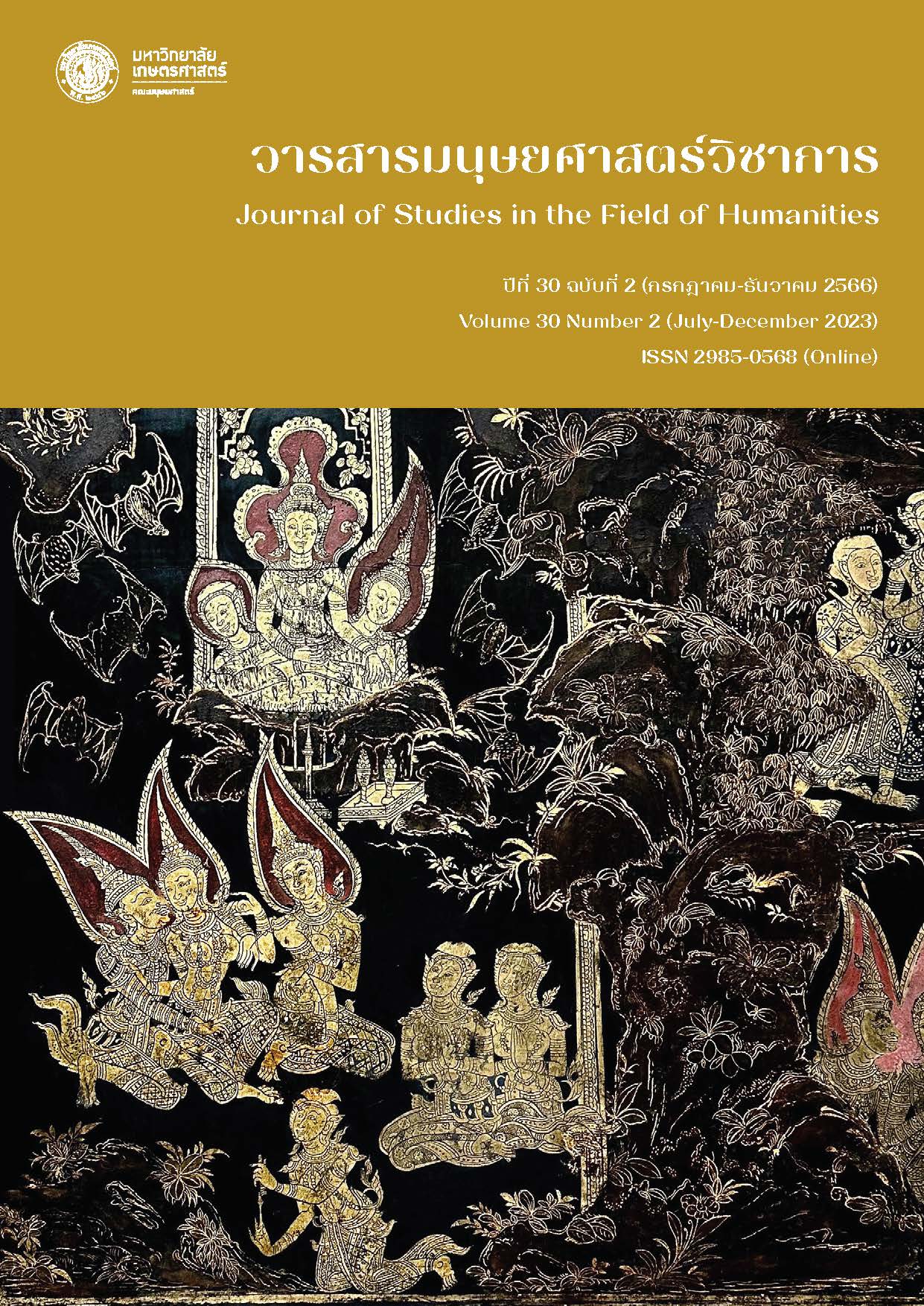Comparative Analysis on Synonym for Adverb of Time in Korean and Thai: A Case Study on Adverbs ““이미-벌써” “지금-이제” “어서-얼른”
Main Article Content
Abstract
The objectives of this study were to 1) identify the specific grammatical meaning and application of the synonym for adverb of time in the Korean language, 2) analyse and compare the specific grammatical meaning and application of the synonym for adverb of time in the Korean and Thai languages. The sample data are the Korean adverb of time: “이미-벌써” “지금-이제” “어서-얼른” which are taken from the Korean dictionary, “표준국어대사전, 연세현대한국어사전”; the Thai dictionary, ‘the Royal Institute Dictionary’ (Royal Society of Thailand, 2011); and other related works on the specific grammatical meaning and grammatically correct usage terms from example sentences.
The results of the study revealed that Korean synonyms for adverb of time with identical meaning and usage can be interchangeable, but it is unreciprocated if its meaning is different. Moreover, the comparative analysis on the specific grammatical meaning and application of the synonym for adverb of time in the Korean and Thai languages presented two significant points. Firstly, the similarity: 1) it can modify the sentence to present the past, the present and the future tense; 2) it can be freely put anywhere in the sentence; and 3) it can be found in affirmative sentences, interrogative sentences, invitations, commands, and exclamations. Secondly, the difference: 1) the Korean synonyms for adverb of time are usually found with the affixes of time ““-었-/-는-/-겠-”, but Thai adverb of time could be found either before or after verb without changing the word form; and 2) if Korean synonyms for adverb of time convey different individual meanings, it is necessary to combine new words, when comparing with Thai, to convey the meaning and terms of use to match the synonym adverbs in Korean.
Article Details

This work is licensed under a Creative Commons Attribution-NonCommercial-NoDerivatives 4.0 International License.
References
กำชัย ทองหล่อ. (2554). หลักภาษาไทย. กรุงเทพฯ: รวมสาส์น (1997).
ดวงเดือน สุวัตถี. (2524). ภาษาศาสตร์กับการเรียนการสอนภาษาต่างประเทศ. กรุงเทพฯ: คณะครุศาสตร์ จุฬาลงกรณ์มหาวิทยาลัย.
นพดล จันทร์เพ็ญ. (2557). หลักการใช้ภาษาไทย. กรุงเทพฯ: เจเนซิส มีเดียคอม.
ปริศ วงศ์ธนเสน. (2552). หลักภาษาเกาหลี. สงขลา: ฝ่ายเทคโนโลยีการศึกษา สำนักวิทยบริการ มหาวิทยาลัยสงขลานครินทร์ วิทยาเขตปัตตานี.
ภาษิตา วิสารสุข. (2537). ภาษาไทย คนไทยต้องพูด-อ่าน-เขียนเป็น. กรุงเทพฯ: แพรธรรม.
วันเพ็ญ เทพโสภา. (2553). หลักภาษาไทย ฉบับนักเรียน. กรุงเทพฯ: ธนธัชการพิมพ์.
วิกิพีเดีย สารานุกรมเสรี. (2564). ภาษาไทย. สืบค้นเมื่อ 20 เมษายน 2564 จาก https://th.wikipedia.org/wiki/%E0%B8%A0%E0%B8%B2%E0%B8%A9%E0%B8%B2%E0%B9%84%E0%B8%97%E0%B8%A2.
สำนักงานราชบัณฑิตยสภา. (2554). พจนานุกรมฉบับราชบัณฑิตยสถาน พ.ศ. 2554. สืบค้นเมื่อ 10 กุมภาพันธ์ 2564 จาก https://dictionary.orst.go.th/index.php].
อุดม วโรตม์สิกขดิตถ์. (2548). ภาษาศาสตร์เบื้องต้น (พิมพ์ครั้งที่ 8). กรุงเทพฯ: มหาวิทยาลัยรามคำแหง.
Iadnuy K. (2013). 태국인 학습자를 위한 정도부사 유의어 교육 방안 연구. 숙명여자대학교 석사학위논문. 국립국어권. 표준국어대사전. สืบค้นเมื่อ 10 กุมภาพันธ์ 2564 จาก https://stdict.korean.go.kr/main/main.do.
김광해. (1987). 유의어반의어 사전. 한샘.
만리. (2010). 한국어 교재의 시간부사 분석 –유의어 시간부사를 중심으로-. 상명대학교 석사학위논문.
문금현. (1989). 현대국어 유의어의 연구 - 유형 분류 및 의미 분석을 중심으로. 서울대학교 대학원 석사학위논문.
문금현. (2004). 한국어 유의어 의미 변별과 교육 방안. 「한국어 교육」15권 3호, 국제 한국어 교육학회.
박덕유. (2006). 학교 문법론의 이해. 역락.
박재남. (2002). 외국어로서 한국어의 유의어 교육 방안 연구. 연세대학교 석사학위논문.
봉미경. (2005). 시간부사의 어휘 변별 정보 연구 - 유의어 방금’과 ‘금방’의 분석 을 중심으로. 「외국어로서의 한국어 교육」제30권, 연세대학교 언어연구 교육원 한국어학당, 113-139.
서정수. (2005). 한국어의 부사. 서울대학교출판부.
손남익. (1995). 국어부사연구. 박이정.
왕단 .(2015). 중국인 학습자를 위한 시간부사 유의어 교육 방안. 전남대학교 석사학위논문.
양송. (2019). 한국어 시간부사 유의어 변별 연구. 연세대학교 석사학위논문.
연세대학교 언어 정보 연구원. 연세현대한국어사전. สืบค้นเมื่อ 10 กุมภาพันธ์ 2564 จากhttps://ilis.yonsei.ac.kr/dic/?keyword=%EB%B2%8C%EC%8D%A8&id=44187&order=.
유현경강현화. (2002). 유사관계 어휘정보를 활용한 어휘교육 방안. 「외국어 로서의 한국어교육」, 제27권 0호, 연세대학교 언어연구교육원 한국어학당, 243-269.
이한우. (2002). 태국어 문법론. 한국외국어대학교 출판부.
조진희. (2005). 한국어 학습자를 위한 유의 시간부사 교수모형. 상명대학교 석사학위논문.
조현선. (1986). 한국어의 시간부사와 시상접미사와의 공존관계에 관한 연구. 연세대학교 석사학위논문.
정영교. (2011). 한국어 교육을 위한 양태부사 유의어 의미 분석과 제시 방안 연구. 세종대학교 석사학위논문.
정환승. (2007). 현대 태국어 문법론. 삼지사.
진희릉. (2015). 중국인 학습자를 위한 시간부사 유의어 교육 연구. 서울대학교 석사학위논문.
차상호. (2012). 가장 알기 쉬운 기초 태국어. 삼지사.
최경아. (2007). 한국어 유의어 교육 방안 연구 -시간부사를 중심으로-. 고려대학교 석사학위논문.
최옥춘. (2013). 한-중 시간부사 유의어 대조 연구 -한국어 중급 학습자를 대상으로-. 경희대학교 석사학위논문.
최현배. (1961). 우리말본. 정음사.
풍심엽. (2018). 중국인 학습자를 위한 한국어 시간 부사 유의어 교육 방안 연구. 한 양 대 학 교 석사학위논문.
황유연. (2020). 한국어 시간부사 유의어 “얼른, 어서, 빨리” 에 관한 연구 – 중국인 학습자를 대상으로-. 건국대학교 석사학위논문.


